
Karine Tawagi, MD, is a medical oncologist in the Division of Hematology & Oncology at the University of Illinois in Chicago. Dr. Tawagi’s clinical focus is the treatment of genitourinary cancers, including bladder, kidney, testicular, and prostate cancers. Her research interests focus on clinical trials in genitourinary cancers, cancer survivorship, improving current gaps in health care, and the use of immunotherapy in cancer treatment while developing strategies to diagnose, treat, and minimize side effects related to immunotherapy. You can follow Dr. Tawagi on Twitter. View Dr. Tawagi’s disclosures.
According to the American Cancer Society, about 1 in 8 men will be diagnosed with prostate cancer during their lifetime. Many can be cured if their disease has not spread outside of the prostate, called localized cancer, and many with more advanced cancer can live for years if the treatment has a good response.
There are several steps patients can take to improve their overall health during treatment, including through exercise. Here, learn more about the important role exercise can play during prostate cancer and what to know about getting started.
Why is exercise important for people with prostate cancer?
Research has shown that exercise can improve overall quality of life, reduce fatigue, and improve mood in people with prostate cancer. Regular exercise has also been shown to help reduce the risk of other health conditions, such as heart disease, diabetes, and obesity, all of which are common in people with prostate cancer.
In addition, several studies have shown that exercise may reduce the risk of prostate cancer recurrence and progression in people who have undergone treatment for their cancer. Exercise has also been shown to help people better tolerate cancer treatments such as radiation therapy and chemotherapy.
What exercise challenges are common for people with prostate cancer?
Patients may face various exercise challenges during treatment, including fatigue. Fatigue is a common side effect of many prostate cancer treatments, including androgen deprivation therapy (ADT), which over half of patients receive as part of their treatment plan. Fatigue can make it difficult to maintain an exercise routine. ADT may also increase the risk of the bone disease osteoporosis, which may make high-impact exercises risky and increase the risk of bone fractures. However, weight-bearing exercises and strength training are also an important strategy for preventing osteoporosis.
Some people with prostate cancer may experience muscle weakness, particularly in the pelvic floor muscles, which can make certain exercises challenging, including those that involve lifting weights. In addition, some treatments for prostate cancer, such as surgery or radiation therapy, can cause urinary incontinence. This can make some exercises, such as high-impact activities or those that involve jumping or bouncing, uncomfortable or difficult.
People receiving chemotherapy for prostate cancer may also be at risk for infections and should consider at-home exercise programs in order to avoid crowded gyms. They should also take precautions with certain exercise machines because of bleeding or bruising risks. Talk with your health care team about which precautions may be necessary for you to take.
What exercises may be helpful for people with prostate cancer?
The type of exercises that may be helpful will vary depending on the person’s individual factors, such as the stage of the cancer, the treatments being received, and their overall health status. Always talk with your doctor about how much and what kinds of exercise are best for you.
The U.S. Department of Health and Human Services recommends that adults get at least 150 minutes of moderate-intensity activity or 75 minutes of vigorous-intensity activity each week. These are some of the exercises that may be offered for people with prostate cancer:
-
Aerobic exercise: This type of exercise includes brisk walking, jogging, biking, swimming, and tennis. Aerobic exercise increases heart rate and breathing, can improve cardiovascular health, reduce fatigue, and improve mood.
-
Resistance training: This involves using weights or resistance bands to build strength and muscle mass. Resistance training can help if muscle weakness and loss has occurred during prostate cancer treatment. Examples of this type of exercise include lifting weights, doing push-ups or squats, or using resistance bands.
-
Pelvic floor exercises: These exercises involve contracting and relaxing the muscles that support the bladder and bowel, such as doing Kegels and pelvic tilts. Pelvic floor exercises can help improve urinary and bowel function.
-
Stretching and flexibility exercises: These exercises can help improve the range of motion, reduce stiffness and joint pain, and improve balance. Examples of stretching exercises include yoga and gentle stretching movements.
How can the health care team help people with prostate cancer with their exercise plan?
The health care team can play an important role in helping patients incorporate exercise into their treatment plan, including educating them about the benefits of exercise, the types of exercises that are safe and appropriate, and how to get started with an exercise program. By working together, the health care team can help people with prostate cancer find exercises that are right for them to improve their quality of life and potentially improve their outcomes. The health care team can also help make connections with specialists who can help with exercise, such as physical therapists or pelvic physical therapists.
It is very important for people with prostate cancer to speak to their health care team about developing an exercise program that is safe and appropriate for their individual needs and circumstances. The program should take into account any physical limitations you may have, treatment side effects, and your overall health status.
Dr. Natalie Reizine, genitourinary medical oncologist at University of Illinois in Chicago, served as a reviewer and contributor for this content. Dr. Reizine has no relationships to disclose.







